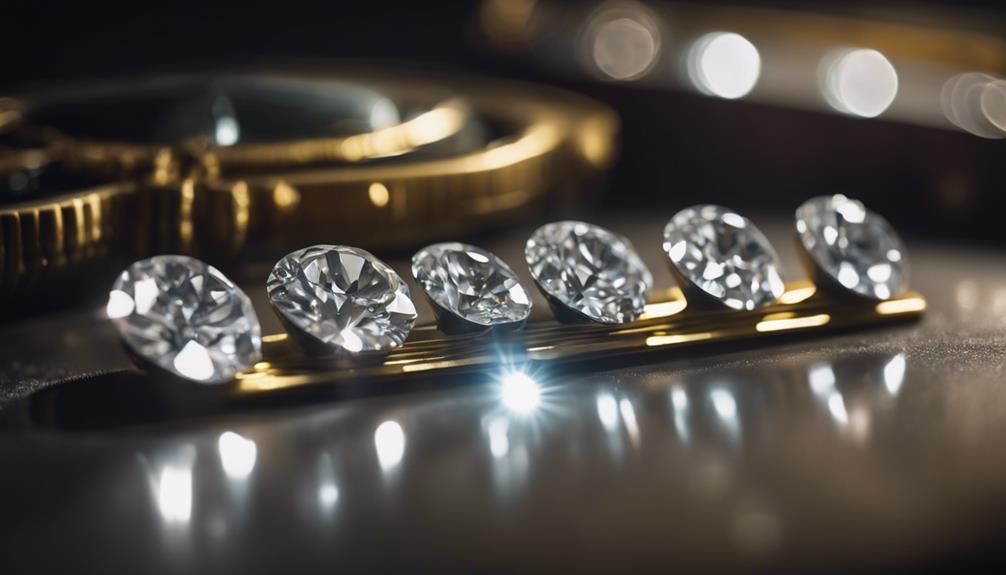When evaluating diamonds, you should focus on the 4 Cs: Color, Clarity, Cut, and Carat weight. Color ranges from D (colorless) to Z (tinted), with D being the most valuable. Clarity grades measure internal inclusions and external blemishes from Flawless (FL) to Included (I2). Carat weight reflects the diamond’s size, with one carat equaling 200 milligrams. Cut determines how well a diamond reflects light, enhancing its brilliance and beauty. Each of these factors impacts a diamond’s value and appearance, making them essential for informed purchasing decisions. To uncover how to balance these elements for the perfect gem, keep going.
What Are the 4 Cs?

The 4 Cs—Color, Clarity, Cut, and Carat weight—are the key factors you’ll need to understand when evaluating diamond quality.
First, let’s talk about color. Diamonds are graded on a scale from D (colorless) to Z (noticeable tint). The closer a diamond is to being colorless, the higher its value, as colorless diamonds are rarer and more sought after.
Next, there’s clarity. Clarity measures the presence of internal inclusions and external blemishes. The grading scale ranges from Flawless (FL), with no imperfections, to Included (I2), where inclusions are visible to the naked eye. A higher clarity grade means fewer imperfections, making the diamond more brilliant and valuable.
Carat weight is another essential factor. It measures how much a diamond weighs, with one carat equal to 200 milligrams. Larger diamonds are generally more expensive, but carat weight isn’t the only aspect determining a diamond’s value.
Lastly, while we won’t dive deep into cut here, know that it’s vital for a diamond’s brilliance and light performance.
Understanding these 4 Cs—color, clarity, carat, and cut—will help you make an informed decision when purchasing a diamond.
Understanding Diamond Cut
When evaluating diamonds, you’ll find that the cut plays an essential role in determining its brilliance and overall visual appeal. The diamond cut greatly influences how well the gem reflects and refracts light, which directly impacts its sparkle.
In diamond grading, cuts are rated from Ideal to Poor. The Ideal and Excellent cuts are best for maximizing light performance, showcasing the diamonds’ beauty at its finest.
Assessing the quality of a diamond cut involves examining the precise alignment of its facets and angles. A well-executed cut enhances how light interacts with the gem, making it appear more beautiful and valuable, sometimes even more so than a larger diamond with a poorly done cut. This highlights the importance of cut quality in the overall assessment of a diamond’s value.
Don’t be misled by the ‘Triple Excellent’ designation, as it doesn’t always guarantee superior beauty. The overall aesthetic is determined by multiple factors, including the quality of the cut.
Evaluating Diamond Color

Grading diamond color involves evaluating its hue on a scale from D (colorless) to Z (noticeable tint), with D being the rarest and most valuable. This grading scale is important because even subtle differences in color grade can greatly impact a diamond’s price. Generally, diamonds closer to D are more costly due to their rarity and exceptional clarity.
When you’re evaluating a diamond, remember that the naked eye often struggles to distinguish between adjacent color grades, so side-by-side comparisons are essential for accurate evaluation.
The diamond’s cut, carat weight, and shape can also influence how the color appears. For instance, when a diamond is cut well, it can mask some of the tint, making it appear whiter than it actually is. Conversely, a larger carat weight might make a hint of color more noticeable. As a result, understanding how these factors interplay is critical for making an informed choice.
Don’t forget, fancy colored diamonds like blue or pink use a different grading system based on hue, tone, and saturation. These diamonds are evaluated separately from the traditional D-to-Z scale, adding another layer of complexity to diamond color evaluation.
Assessing Diamond Clarity
Evaluating diamond clarity involves scrutinizing the presence of internal inclusions and external blemishes that might affect the gem’s brilliance and overall appeal. When you’re reviewing diamond clarity, you’re fundamentally examining how these imperfections impact the stone’s look and light performance.
The GIA clarity grading system ranges from Flawless (FL) to Included (I2), with each grade reflecting the visibility of these clarity characteristics. Most inclusions and blemishes are microscopic, meaning they often don’t detract from the diamond’s beauty to the naked eye. A diamond that’s eye-clean appears perfect without magnification, even if it has minor inclusions. However, clarity greatly affects diamond value, as diamonds with fewer visible imperfections are rarer and more sought after.
Here are some key points to reflect on:
- Flawless diamonds are extremely rare and carry a premium price.
- Very Slightly Included (VS1-VS2) diamonds have minor inclusions that are difficult to see under 10x magnification.
- Slightly Included (SI1-SI2) diamonds may have noticeable inclusions but can still appear eye-clean.
- Included (I1-I2) diamonds have obvious inclusions that can affect brilliance and durability.
Carat Weight Explained

Understanding carat weight is essential for appreciating a diamond’s size and its impact on value. Carat weight measures how heavy a diamond is, with one carat equivalent to 200 milligrams or 0.2 grams. It’s the most accepted standard for gauging diamond size, and because larger diamonds are rarer, they often come with a heftier price tag.
However, carat weight alone doesn’t determine diamond quality. A diamond’s perceived size can be influenced by its cut; a well-cut diamond can appear larger than a poorly cut one of the same carat weight. So, when you’re trying to find the perfect diamond, consider balancing carat weight with the other three Cs—color, clarity, and cut—to achieve the best overall value and visual appeal.
Diamonds are often subdivided into 100 points for precise measurements. For example, a 50-point diamond is half a carat. This objectivity in grading allows you to make straightforward comparisons between diamonds based solely on weight.
Conclusion
By mastering the 4 Cs—cut, color, clarity, and carat weight—you’ll confidently navigate the diamond market.
Understanding how each factor affects a diamond’s beauty and value guarantees you make informed decisions.
Whether you’re seeking the perfect engagement ring or a timeless investment, knowing these essentials will guide you to a choice that aligns with your tastes and holds lasting value.
So, trust your knowledge and choose a diamond that truly shines.



